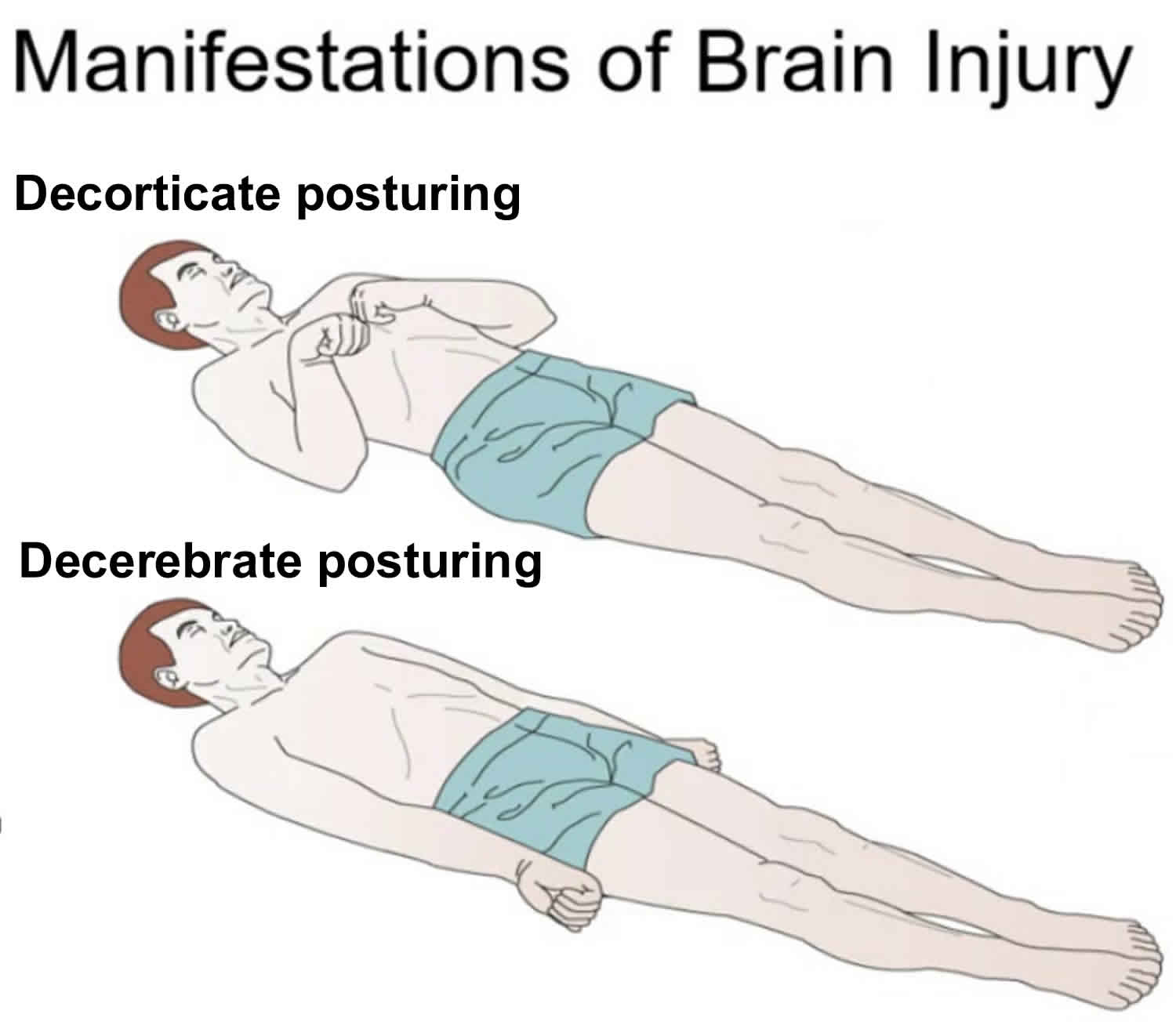What is decorticate posturing
Decorticate posturing is an abnormal posturing and it is defined as semi-flexion, adduction and internal rotation at the shoulders and semi-flexion or flexion at the elbows, clenched fists, and legs held out straight 1. The arms are bent in toward the body and the wrists and fingers are bent and held on the chest.
Decorticate posturing is a sign of severe damage in the brain injury such as damage in the cerebral hemispheres, the internal capsule, and the thalamus 2.
People who have decorticate rigidity should get medical attention right away.
Decorticate posturing is a sign of damage to the nerve pathway between the brain and spinal cord. Although it is serious, it is usually not as serious as a type of abnormal posture called decerebrate posturing.
Decorticate posturing may occur on one or both sides of the body.
Figure 1. Decorticate and decerebrate posturing
Decorticate posturing causes
Causes of decorticate posturing include:
- Bleeding in the brain from any cause
- Brain stem tumor
- Stroke
- Brain problem due to drugs, poisoning, or infection
- Traumatic brain injury
- Brain problem due to liver failure
- Increased pressure in the brain from any cause
- Brain tumor
- Infection, such as Reye syndrome
Decorticate posturing treatment
The person will receive emergency treatment. This includes getting a breathing tube and breathing assistance. The person will likely be admitted to the hospital and placed in the intensive care unit.
After the condition is stable, the provider will get a medical history from family members or friends and a more detailed physical examination will be done. This will include a careful examination of the brain and nervous system.
Medical history questions may include:
- When did the symptoms start?
- Is there a pattern to the episodes?
- Is the body posture always the same?
- Is there any history of a head injury or drug use?
- What other symptoms occurred before or with the abnormal posturing?
Tests that may be done include:
- Blood and urine tests to check blood counts, screen for drugs and toxic substances, and measure body chemicals and minerals
- Cerebral angiography (a dye and x-ray study of blood vessels in the brain)
- MRI or CT scan of the head
- EEG (brain wave testing)
- Intracranial pressure (ICP) monitoring
- Lumbar puncture to collect cerebrospinal fluid
The outlook depends on the cause. There may be brain and nervous system injury and permanent brain damage, which can lead to:
- Coma
- Inability to communicate
- Paralysis
- Seizures
Decorticate vs Decerebrate posturing
Decerebrate posturing is an abnormal body posture and it is defined the arms and legs being held straight out, the toes being pointed downward, and the head and neck being arched backward 1. Decerebrate posturing usually means there has been severe damage to the brain.
A severe injury to the brain is the usual cause of decerebrate posturing.
Opisthotonos (a severe muscle spasm of the neck and back) may occur in severe cases of decerebrate posturing.
Decerebrate posturing can occur on one side, on both sides, or in just the arms. It may alternate with decorticate posturing. A person can also have decorticate posturing on one side of the body and decerebrate posturing on the other side.
Conditions related to decerebrate posture need to be treated right away in a hospital.
Decerebrate posturing causes
Causes of decerebrate posture include:
- Bleeding in the brain from any cause
- Brain stem tumor
- Stroke
- Brain problem due to drugs, poisoning, or infection
- Traumatic brain injury
- Brain problem due to liver failure
- Increased pressure in the brain from any cause
- Brain tumor
- Infection, such as Reye syndrome
Decerebrate posturing treatment
The person will need emergency treatment right away. This includes breathing assistance and placement of a breathing tube. The person will likely be admitted to the hospital and placed in intensive care.
Once the person is stable, the provider will obtain a complete medical history from family members or friends and do a more complete physical examination. This will include a careful examination of the brain and nervous system.
Family members will be asked questions about the person’s medical history, including:
- When did the symptoms start?
- Is there a pattern to the episodes?
- Is the body posturing always the same?
- Is there any history of a head injury or other condition?
- What other symptoms came before or with the abnormal posturing?
Tests may include:
- Blood and urine tests to check blood counts, screen for drugs and toxic substances, and measure body chemicals and minerals
- Cerebral angiography (dye and x-ray study of blood vessels in the brain)
- CT or MRI of the head
- EEG (brain wave testing)
- Intracranial pressure (ICP) monitoring
- Lumbar puncture to collect cerebrospinal fluid
The outlook depends on the cause. There may be brain and nervous system injury and permanent brain damage, which can lead to:
- Coma
- Inability to communicate
- Paralysis
- Seizures
- Idro R, Otieno G, White S, et al. Decorticate, decerebrate and opisthotonic posturing and seizures in Kenyan children with cerebral malaria. Malar J. 2005;4:57. Published 2005 Dec 7. doi:10.1186/1475-2875-4-57 https://www.ncbi.nlm.nih.gov/pmc/articles/PMC1326205
- Jung W, Kwon S, Park S, et al. Electroacupuncture for decorticate rigidity of the upper limbs in a patient with anoxic brain damage. Case Rep Med. 2013;2013:524603. doi:10.1155/2013/524603 https://www.ncbi.nlm.nih.gov/pmc/articles/PMC3806514






